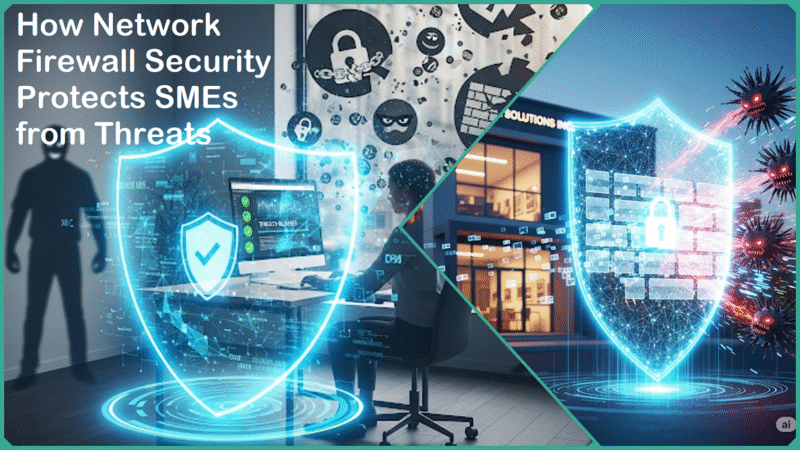Top Cybersecurity Skills Beyond the Firewall for Businesses
Estimated reading time: 18 minutes
Cybersecurity is no longer solely focused on strengthening and defending your network perimeter against external threats. In today’s digital landscape, the most advanced and sophisticated cyberattacks increasingly target vulnerabilities that exist within the organization itself. These weaknesses can be found across a wide range of areas, including devices, applications, cloud environments, and, most importantly, the people who interact with these systems daily.
For small and medium-sized business owners, IT managers, aspiring security professionals, and business leaders alike, it is essential to expand your cybersecurity skills beyond just understanding firewalls. Developing a broader, more comprehensive knowledge of cybersecurity practices is crucial for ensuring real-world protection against a wide range of digital threats.

This expanded expertise not only safeguards your organization’s sensitive data but also supports sustainable growth by building a stronger, more resilient security foundation that can adapt to evolving cyber risks and challenges.
This post delves deeply into the essential cybersecurity skills that modern businesses must develop to protect their digital assets effectively. It explains why these skills are crucial in today’s rapidly evolving threat landscape and offers practical strategies for implementing them, even when operating under tight budget constraints or with limited resources.
By mastering and leveraging these capabilities, your organization will be better equipped to anticipate potential cyber threats, mitigate risks proactively, and respond swiftly and effectively to incidents, thereby enhancing your overall security posture like never before.
Shifting the Security Mindset: From Perimeter to People and Data
The transition from traditional perimeter-focused security measures to a more comprehensive and holistic defense strategy—one that emphasizes protecting people and sensitive data—is critical in today’s rapidly evolving cybersecurity landscape for several important and compelling reasons:
Evolving Threat Vectors
Traditional firewalls have long been designed mainly to protect the network perimeter, acting as a first line of defense against external threats. However, in today’s rapidly changing digital landscape, many modern cyber threats are capable of bypassing these perimeter-based controls entirely.
Attackers frequently exploit sophisticated social engineering tactics to manipulate and deceive unsuspecting employees, gaining unauthorized access through human error. Additionally, they often leverage stolen or compromised credentials to infiltrate cloud environments, where traditional firewalls offer limited protection.
Moreover, the widespread use of remote work has introduced numerous rogue devices that connect outside the secure network, creating new vulnerabilities. As a result, the most valuable and vulnerable assets have shifted to people and sensitive data, making them prime targets for increasingly advanced cyberattacks.
Increased Remote Work and BYOD
The significant and rapid rise of remote work arrangements, along with the widespread and growing adoption of bring-your-own-device (BYOD) policies, has dramatically and fundamentally extended the traditional boundaries of organizations in ways that were previously unimaginable.
Employees now frequently connect to corporate resources from locations outside the conventional secure network perimeter, often utilizing unmanaged personal devices and networks that are not fully controlled by the organization. In this evolving landscape, relying solely on traditional firewalls is no longer sufficient to ensure security.
Consequently, there is a growing need for advanced skills in endpoint security, cloud security, and human-centric defense strategies, which are essential for effectively identifying, managing, and mitigating the associated risks in this more complex and distributed work environment.
Cloud Migration Complexities
As more businesses transition their services and data to hybrid or multi-cloud environments, the landscape of security responsibilities undergoes significant changes. Instead of relying solely on traditional network-bound tools, organizations must now focus on cloud-native controls, robust identity and access management strategies, advanced encryption methods, and continuous compliance monitoring to protect their assets effectively.
In today’s rapidly evolving and ever-changing technological environment, relying solely on traditional firewall-centric defenses is no longer sufficient or effective to adequately address the numerous and complex challenges posed by such a dynamic, diverse, and widely distributed infrastructure landscape.
Cost and Impact of Breaches
The average global cost of a data breach in 2024 reached an astounding $4.45 million, which is more than double the amount recorded just ten years ago. This significant increase highlights the growing financial risks associated with data breaches.
Additionally, over 43% of cyberattacks are aimed specifically at small and medium-sized businesses (SMBs), taking advantage of their often weaker security measures and the common misconception that relying solely on firewalls provides sufficient protection.
The severe financial losses and damage to a company’s reputation emphasize the critical importance of implementing a comprehensive, layered security approach. Moreover, it is essential to develop and maintain proactive cybersecurity skills that address every aspect of the business environment, ensuring robust protection against evolving threats.
Business Enablement Through Cybersecurity
Elevating cybersecurity skills beyond the basic task of managing firewalls fundamentally transforms the role of security from being viewed solely as a responsibility confined to the IT department into a crucial business enabler that significantly impacts and supports the entire organization at every level. This broader approach integrates security practices into all aspects of the business, enhancing overall resilience and operational effectiveness.
This comprehensive approach empowers companies not only to effectively defend against a wide range of cyber threats but also to drive innovation, ensure compliance with complex regulatory requirements, and build long-term resilience in an increasingly digital world.
By carefully aligning and integrating cybersecurity strategies directly with the broader and overarching business objectives, organizations become significantly better equipped, more resilient, and considerably more agile in effectively facing future challenges, emerging threats, and constantly evolving risks in today’s dynamic digital landscape.
In Summary
Mastering a comprehensive range of technical, strategic, and human-centric cybersecurity skills that go far beyond just managing firewalls is essential in order to effectively protect entire businesses within today’s increasingly complex and ever-evolving threat landscape.
Developing these advanced capabilities is critical not only to safeguard valuable digital assets but also to significantly reduce the rapidly escalating costs and extensive damages caused by cyber incidents that continue to grow in both frequency and sophistication across all industries.
This comprehensive and holistic mindset serves as the essential foundation for constructing highly effective and robust defenses that seamlessly integrate people, processes, data, and technology in perfect harmony and alignment.
Key Cybersecurity Skills Beyond the Firewall
While firewalls remain a critical first line of defense, modern cybersecurity is about far more than just network perimeters. In today’s interconnected world, threats are increasingly sophisticated and come from all angles—from cloud environments to human error. To truly secure a business, professionals need a broader skillset that extends beyond traditional network security.
Let’s explore the top cybersecurity skills that are essential for protecting against these new and evolving threats, ensuring your business and career are prepared for the challenges of tomorrow.
Human Element: Social Engineering, Phishing Defense, and Employee Training
Why it matters: Human error continues to be the primary cause behind the majority of security breaches experienced by organizations worldwide. Cyber attackers frequently take advantage of inherent human traits such as trust and the sense of urgency, using these vulnerabilities to execute sophisticated phishing schemes and social engineering attacks.
These types of attacks are especially dangerous because they often manage to bypass even the most advanced technical security defenses, putting sensitive data and systems at significant risk.
Critical skills:
- Recognizing phishing, impersonation, and social engineering tactics in emails, calls, or messages.
- Building a cybersecurity-aware culture through ongoing awareness training, simulated phishing exercises, and open reporting channels.
- Educating employees on incident escalation protocols without fear of blame or retribution.
Case study: A small to medium-sized business (SMB) successfully reduced the number of phishing incidents by implementing a comprehensive cybersecurity strategy. This strategy involved conducting quarterly phishing simulation exercises designed to test and improve employee vigilance. In addition, the company launched monthly security awareness campaigns to continuously educate staff about the latest phishing threats and best practices.
To further encourage active participation, the organization introduced gamification elements that rewarded employees for promptly identifying and reporting suspicious emails, significantly enhancing overall security awareness and reducing phishing-related risks.
Actionable steps:
- Host quarterly social engineering awareness sessions.
- Display posters and distribute brief reminders with real incident examples.
- Foster an open, no-blame culture encouraging employees to ask questions and report anomalies without hesitation.
Cloud Security: Multi-Cloud & Hybrid Environments
Why it matters: Cloud adoption brings with it a variety of new security complexities that organizations must carefully manage. Additionally, it significantly expands the attack surface, making it larger and more dynamic, which in turn increases the potential vulnerabilities and threats that need to be addressed.
Critical skills:
- Mastering Cloud Security Posture Management (CSPM) to continuously monitor misconfigurations and ensure compliance.
- Implementing robust Identity and Access Management (IAM) principles such as least privilege, single sign-on, and multi-factor authentication.
- Ensuring data encryption both at rest and in transit, along with cloud-native key management.
- Utilizing Security Information and Event Management (SIEM) tools like Splunk or AWS GuardDuty for real-time threat detection.
Actionable steps:
- Provide ongoing cloud security training for IT teams.
- Deploy cloud-native security tools such as AWS CloudTrail, Azure Security Center, or Google Cloud Security Command Center.
- Automate compliance and monitoring with CSPM solutions.
Endpoint Security: Securing Devices Everywhere
Why it matters: Endpoints such as laptops, mobile phones, and a wide range of Internet of Things (IoT) devices serve as crucial entry points that attackers frequently target to gain unauthorized access and compromise security.
Critical skills:
- Maintaining a comprehensive inventory of connected devices.
- Automating patch management to timely address vulnerabilities.
- Applying the Principle of Least Privilege (POLP) to minimize user access rights.
- Enforce encryption and strong authentication methods like multi-factor authentication.
Best practices:
- Implement Zero Trust Architecture: verify every device and user continuously.
- Use Mobile Device Management (MDM) solutions to enforce security policies and automate patching.
- Educate staff on securing both personal and company devices and enforce BYOD compliance.
Incident Response & Digital Forensics
Why it matters: A swift and effective response to security breaches is crucial because it significantly limits the extent of damage caused and plays a vital role in facilitating a faster recovery process. Addressing breaches promptly helps to contain the incident, minimize data loss, and reduce overall impact on operations. This proactive approach not only protects sensitive information but also strengthens the organization’s resilience against future attacks.
Critical skills:
- Developing, practicing, and refining incident response (IR) plans that fit SMB resources.
- Conducting digital forensics to identify breach causes, collect evidence, and support future defenses.
- Analyzing threat intelligence and log data to map breach scope and origin.
Actionable steps:
- Establish clear IR playbooks covering escalation, containment, eradication, and recovery.
- Train teams on evidence preservation and forensic basics based on SANS or NIST guidelines.
- Partner with external forensics and legal experts when needed.
Data Protection: Encryption, Data Loss Prevention (DLP), and Access Management
Why it matters: Protected and properly managed data represents the most challenging and secure target for attackers to breach. Ensuring data is well-guarded and effectively controlled significantly reduces the risk of unauthorized access and potential security threats. This level of protection is vital in maintaining the integrity and confidentiality of sensitive information.
Critical skills:
- Classifying data by sensitivity and applying tailored controls.
- Leveraging modern encryption standards like AES, RSA, and TLS for data at rest and in transit.
- Using DLP tools to prevent unauthorized data exposure or transfers.
- Automating access control with least privilege policies and conducting regular audits.
Best practices:
- Keep updated inventories of users, roles, and access rights.
- Empower data owners to review access requests regularly.
- Implement automated reporting and periodic access certification aligned with business needs.
Strategic and Analytical Skills: Risk Quantification and Continuous Learning
Why it matters: Cybersecurity is an exceptionally fast-paced and continuously evolving discipline that demands not only technical expertise but also significant foresight and adaptability. As new threats and vulnerabilities emerge regularly, staying ahead requires constant vigilance and the ability to anticipate changes in the digital landscape.
Critical skills:
- Quantifying cyber risks using business-centric financial models and risk assessment frameworks.
- Navigating compliance landscapes such as GDPR, SOC 2, and NIST.
- Collaborating across legal, HR, development, and executive teams to align cybersecurity initiatives with business goals.
Pro tip: Actively engage with various industry communities and professional groups, participate in forums and discussions to expand your network, and commit to continuous learning by pursuing recognized certifications such as CISSP or CISM. Additionally, make it a priority to stay well-informed about the latest emerging threats, advancements, and cutting-edge technologies in the cybersecurity field to maintain a competitive edge.
These skills embody the contemporary, multi-layered strategy that is essential for effectively safeguarding businesses both now and in the future. This approach goes far beyond the basic, traditional firewall defenses, expanding to include a comprehensive and proactive cybersecurity posture designed to anticipate and counter a wide range of evolving threats in an increasingly complex digital landscape.
Quick Comparison of Cybersecurity Skills
| Skill Area | Implementation Focus | Tools / Approaches | Action Steps |
|---|---|---|---|
| Social Engineering Defense | Human-centric security, training | Awareness sessions, policy documents | Quarterly training sessions, gamified reporting |
| Cloud Security | Multi-cloud environments, IAM, CSPM | AWS, Azure, Google tools; SIEM (Splunk, AWS GuardDuty) | Adopt cloud-native tools; ongoing monitoring |
| Endpoint Security | Zero Trust, asset inventory, MDM | EDR, XDR, and Mobile Device Management (MDM) platforms | Patch management, automate controls |
| Incident Response / Forensics | Playbooks, forensics preparation | SANS/NIST frameworks, Incident Response (IR) tools | Develop and test IR plans; conduct periodic drills |
| Data Protection | Data Loss Prevention (DLP), encryption, and auditing | DLP tools, Cloud Key Management Service (KMS), and audit platforms | Run access certification, enforce least privilege |
| Strategic Skills | Risk quantification, compliance | Risk management platforms | Align security initiatives with business roadmaps |
This table highlights the critical cybersecurity skill areas that extend well beyond just the firewall, detailing the specific focus of their implementation, the primary tools and methodologies commonly employed in these areas, along with concrete, practical action steps designed to help organizations comprehensively strengthen their overall security posture effectively and sustainably.
Current Trends and Developments in Cybersecurity Skills
Current cybersecurity trends and technological developments are rapidly and profoundly transforming the methods businesses use to defend themselves against a constantly evolving landscape of cyber threats. These innovations and shifts are reshaping traditional security paradigms and introducing new strategies to stay ahead of attackers.
Here are some of the most impactful and influential advances that are actively shaping and defining security strategies and practices in the year 2025:
AI-driven Defenses
Artificial Intelligence (AI) and Machine Learning are now central to real-time anomaly detection, especially effective in identifying phishing attempts and social engineering attacks. AI-powered systems analyze vast data streams rapidly, spotting subtle behavioral deviations that manual inspection might miss.
Moreover, AI technology enables highly effective autonomous threat responses, such as automatically quarantining compromised devices or instantly blocking malicious traffic. These capabilities are essential in countering cyberattacks that can rapidly evolve and spread within just a few minutes. By acting quickly and without human intervention, AI helps prevent widespread damage and ensures network security in real time.
These capabilities free cybersecurity teams to focus on higher-level threat hunting and strategic tasks. Importantly, organizations are prioritizing privacy-preserving AI solutions that keep sensitive data within controlled environments while still benefiting from advanced analytics.
Zero Trust Architecture
The zero trust model—often summarized by the phrase “never trust, always verify”—continues to serve as a fundamental and essential security principle in today’s cybersecurity landscape. This approach mandates continuous and rigorous authentication of both users and devices attempting to access systems.
Additionally, it involves the micro-segmentation of networks, which effectively limits lateral movement within the network by isolating different segments. Strict access controls are also a critical component, ensuring that permissions are carefully managed and enforced.
This architectural shift represents a significant change in mindset by acknowledging that security threats can arise from any location, including from within traditional network perimeters, thereby placing a strong emphasis on verifying every single access attempt regardless of where it originates.
Cloud-native Security
With the widespread and accelerating migration to cloud and hybrid computing environments, security measures are becoming increasingly integrated directly into cloud-based applications and platforms. Automated security controls are progressively replacing traditional manual configurations, which not only improves compliance with regulatory standards but also significantly reduces the risk of human error.
Advanced AI-enhanced cloud security tools are now able to continuously monitor configuration drift, promptly detect anomalous behaviors, and enforce comprehensive security policies in dynamic and scalable ways. These capabilities are particularly well-suited to the complex demands of multi-cloud architectures, ensuring robust protection across diverse cloud ecosystems.
Compliance Automation
Regulatory requirements such as GDPR, SOC 2, and various industry-specific standards are increasingly driving organizations to adopt automated compliance monitoring solutions. These advanced tools offer continuous and real-time visibility into the current adherence status, making it easier to track compliance at all times.
They also generate detailed audit reports automatically and send timely alerts whenever deviations or potential issues are detected. This automation significantly reduces the manual workload on compliance teams and allows organizations to ensure proactive risk management by addressing problems before they escalate.
In Summary
- Artificial intelligence enables significantly faster and more efficient automated detection and response to various security threats, while simultaneously enhancing the depth and accuracy of threat intelligence gathering and analysis.
- Zero Trust frameworks rigorously enforce stringent and continuous verification processes for users, devices, and applications at all times. This approach ensures that every access request is thoroughly validated, regardless of the user’s location or device, maintaining a high level of security and reducing the risk of unauthorized access.
- Security is fundamentally integrated into modern cloud platforms, which utilize advanced automation technologies to continuously manage security posture and detect potential threats. These platforms are designed to proactively identify vulnerabilities and respond to security incidents in real time, significantly enhancing overall protection. By automating critical security processes, organizations can maintain a robust defense against evolving cyber threats while reducing manual effort and improving efficiency.
- Compliance processes are significantly streamlined through the use of advanced automation technologies, which seamlessly integrate governance principles directly into everyday operational workflows. This approach not only enhances efficiency but also ensures that regulatory requirements are consistently met throughout all business activities.
Together, these significant developments fundamentally transform the field of cybersecurity, moving it away from merely reactive defense mechanisms toward a more proactive, intelligent, and adaptive form of resilience. This advanced approach is specifically tailored to address the complexities and challenges presented by the constantly evolving modern threat landscape.
FAQs
What is the most overlooked cybersecurity skill for SMBs?
Human-centric security training continues to be the most overlooked and neglected aspect of cybersecurity efforts. Even though many small and medium-sized businesses invest significantly in advanced technology and security tools, they often fail to provide their employees with sufficient training on how to recognize and respond to common threats such as phishing attacks and social engineering tactics.
This lack of proper training creates critical security gaps within their organizations, which cyber attackers readily exploit to gain unauthorized access and cause significant harm.
How often should incident response plans be tested?
Incident response (IR) plans should be thoroughly tested at least once every year to ensure their effectiveness and readiness. In environments that are particularly dynamic or carry higher risks, it is highly recommended to conduct these tests every quarter.
Using simulated scenarios that are specifically tailored to an SMB’s unique systems and workflows plays a crucial role in helping response teams become well-prepared. This approach ensures that when an actual incident occurs, the team can respond efficiently and effectively, minimizing potential damage and downtime.
Are cloud and endpoint security skills relevant for non-IT leaders?
Executives and managers must possess at least a foundational understanding of cloud and endpoint security risks to effectively prioritize security initiatives, allocate appropriate budgets, and provide strong support for the IT team’s efforts in securing the overall business environment. This basic knowledge enables leadership to make informed decisions that help protect the organization from evolving cyber threats and ensure a robust security posture across all digital assets.
What frameworks should guide data protection and access management?
Small and medium-sized businesses (SMBs) should strongly consider adopting well-established, practical cybersecurity frameworks such as those developed by NIST, CIS, and ISO. These frameworks offer scalable and flexible guidelines specifically designed to accommodate organizations with limited resources, helping them implement effective security controls without overwhelming their capacities.
By following these recognized standards, SMBs can ensure they maintain compliance with relevant regulations while significantly reducing their exposure to various cybersecurity risks and threats.
Can tools alone prevent social engineering attacks?
Technology plays a crucial role in supporting defensive efforts, yet it cannot fully replace the value of well-trained, security-aware employees who remain vigilant. Establishing a robust security culture through comprehensive education and ongoing awareness programs is essential to effectively identify, prevent, and counteract a wide range of social engineering threats.
In Conclusion
Cybersecurity today is a critical business imperative, extending far beyond traditional IT concerns. The advanced skills discussed—ranging from human-centric defenses and cloud security to incident response and strategic risk management—equip SMB owners, IT managers, aspiring cybersecurity professionals, and business leaders with the tools to defend their organizations effectively.
To build a resilient security posture, start by auditing your current skill gaps and security practices. Prioritize ongoing employee training, adopt proven cybersecurity strategies, and invest in cloud and endpoint security expertise tailored to your organization’s needs. This holistic approach strengthens your defenses, reduces risks, and prepares your business to adapt and thrive in an increasingly complex threat landscape.
For continuous guidance, practical tips, and the latest cybersecurity resources, subscribe to our newsletter. Empower your team with next-level cybersecurity skills and keep your business secure every day.






